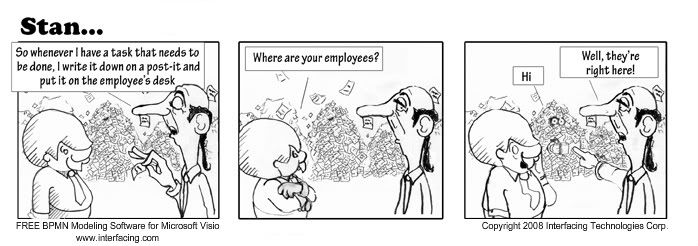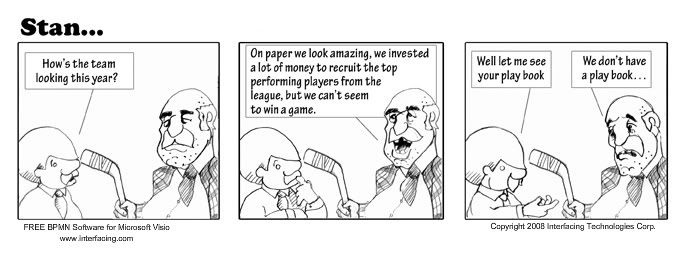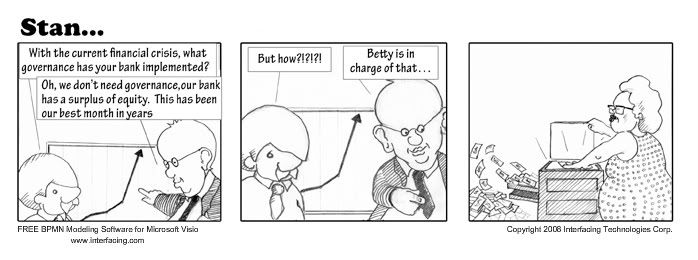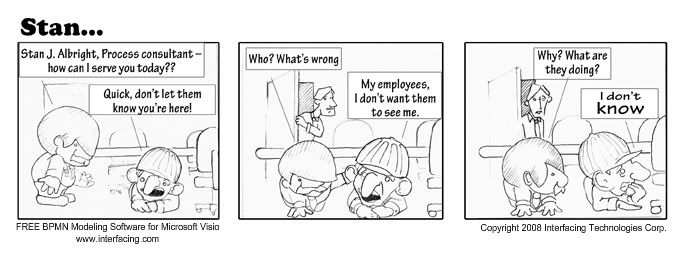Technology is indeed the type of thing that needs to be used properly in order for it to be effective. BPM software, coupled with work flow software has revolutionized all levels of business. Being able to visualize business processes and add automation to them has led to further optimization and efficiency.
The need to use BPM software properly requires that your as-is processes are documented properly. Only once this Process Discovery phase has been completed can you design and implement to-be processes that reflect a fully optimized process.
Many people find that using consulting services for small projects is a waste of money. Instead, before implementing BPM projects and mapping your processes, I suggest taking an OCEB (OMG Certificed Expert in BPM) Training course. The courses are relatively cheap, and give you a comprehensive knowledge on how to map your business processes properly so that your company does not spend their money optimizing a bad process.
Once you've done this, I suggest using one of the 100% Free BPMN Modeling programs - a few of them are ad-ons to Microsoft Visio. They allow you to get started with your process mapping right away.
Thursday, March 26, 2009
How to Adopt Effective GRC Strategies
As a management consultant, every day I walk into businesses seeking effective GRC strategies for their companies. As the article outlines quite well, today formulating a GRC strategy is at hte top of every corporation's laundry list.
In order for a corporation to implement an effective strategy it is necessary to adopt Business Process Management technology. Using BPM software, your company is able to visualize your business processes and ensure that operations are optimized. Beyond that, BPM suites such as Interfacing's Enterprise Process Center specialize in GRC and risk assessment. The program is designed to allow managers to highlight risks within processes, and tie controls to each process as a means to mitigate those very risks. Beyond this, the programs allow you to tie Business Rules and overall strategy to your processes which creates a clearer understanding of your company.
By clearly outlining risks, controls, and rules, employees then use a personalized web-portal homepage and can view everything that pertains to them. Strategies and rules are formalized and accessible at the tip of your fingers, all in an automated, notification based environment.
I suggest downloading the 100% Free BPMN Modeler for Microsoft Visio .
In order for a corporation to implement an effective strategy it is necessary to adopt Business Process Management technology. Using BPM software, your company is able to visualize your business processes and ensure that operations are optimized. Beyond that, BPM suites such as Interfacing's Enterprise Process Center specialize in GRC and risk assessment. The program is designed to allow managers to highlight risks within processes, and tie controls to each process as a means to mitigate those very risks. Beyond this, the programs allow you to tie Business Rules and overall strategy to your processes which creates a clearer understanding of your company.
By clearly outlining risks, controls, and rules, employees then use a personalized web-portal homepage and can view everything that pertains to them. Strategies and rules are formalized and accessible at the tip of your fingers, all in an automated, notification based environment.
I suggest downloading the 100% Free BPMN Modeler for Microsoft Visio .
Tuesday, November 4, 2008
Document Management: The Backbone of Corporations

Within any corporation, organization is essential for maximum productivity and efficiency standards to be achieved. It is surprising the number of corporations that I walk into who have no organizational management or content management systems in place. Those corporations that do have these management systems in place often use them in less than optimal ways. As the backbone of every organization, information should be handled in a way that ensures easy access for those who are authorized, while providing a clear context for a document’s purpose and objective. Roles and resources need to be clearly defined and tasks must be distributed in a plausible manner – certainly not via sticky note.
Employees are a company’s most important investment and in order to ensure that they perform to their full potential, managers must be able to clearly assign roles for them. In addition, employees must be able to clearly visualize what tasks are their responsibility, while having clear access to all the information needed in order to do their job properly. Business Process Management software ensures that tasks and duties are properly assigned, by assigning specific roles to human resources. Employees are given ownership of their tasks, ensuring that there are no redundancies in task execution and that no task is left unfulfilled. Through the use of personalized employee web-portals, employees can clearly see what tasks they have to do each day, and what is expected from them. This ensures not only that tasks do not get ‘lost’, but also that managers can easily keep track of the workload of their employees. In the end, ensuring that organizational management is upheld leads to greater efficiency and cooperation within your company.
Ensuring that a corporation has an efficient and effective content management system is a daunting task. Often companies store all of their documents and data on separate information silos, making it difficult for employees to find what they are looking for. Poor content management poses serious problems for any business, regardless of size. Without organization, security is sacrificed as secure documents can be lost or mishandled.
BPM software allows for content management to be optimized. Company knowledge is immediately available to process users, employees, and managers. Much more than only a repository, BPM software houses a fully integrated content management system which allows users to store valuable documentation in a secure, central location for easy access by all employees. Documents are given a clear purpose by linking them to specific processes ensuring maximum efficiency and productivity.
Taking the necessary steps to ensure that your company is properly organized can yield results immediately. Business Process Management software provides a relatively easy solution to organizational problems within any company, a task that should be at the top of your to do list. Where is that list anyways?
100% FREE BPMN Modeling Software for Microsoft Visio
Thursday, October 23, 2008
BI & BPM: Today's Business Necessities

In today’s business world there exists a dire need for corporations to optimize their business processes in order to cut costs and improve productivity. Although this has been an age old goal for companies, today the need for these cost saving measures is extreme. 70 years ago, the Fordist mentality saw this process as creating economies of scale, and economies of scope. Today, the process of cutting costs differs greatly – vertical integration, outsourcing, streamlining business activities, strategic forecasting and most importantly, improving business processes.
More and more businesses are looking to Business Intelligence software to optimize their operations. Business Intelligence refers to the applications, technologies, and practices that analyze, collect, interpret and integrate data in order to make it applicable to your business. A vital resource, business intelligence collects the raw data of your company so that you can analyze and react to your business’ needs with the highest degree of accuracy.
What is BI without Business Process Management software ? This is a highly contested debate in current industry literature, as analysts are trying to establish whether BI and BPM software are converging or heading in different directions. To me, the answer is quite simple. BI is extremely useful and an absolute necessity for every company. This software, however, is somewhat useless without BPM software . Without BPM, BI has no automated influence on actual process; it is just the raw analysis of numbers. BPM allows you to relate those numbers in real time to your business processes .
As Forrester analyst Connie Moore states, "I think the BI vendors are missing the boat on process," Moore told internetnews.com. "They don't really understand process because they focus on analysis of data. Operational data, tactical data, strategic data; the data needs to be put into action. The BI vendors don't understand the whole process world."
Walking into corporations across North America, I often immediately see a need for Business Intelligence solutions. Corporations spend millions of dollars each year hiring the best staff. On top of this, corporations put countless resources into the collection and analysis of data. But just like a hockey team, you can spend millions of dollars to ensure that you have the best players and reports, but without mapping and documenting your team’s plays, there is no way to use the data effectively.
Thursday, October 16, 2008
GRC And The Financial Crisis: The BPM Solution?

Over the past 6 months, US markets have posted their highest losses since the Great Depression. With the closing of America’s oldest banks and mortgage lenders such as Lehman Brothers, Fannie and Freddie, US markets have been plunging - with world markets now following suit. Analysts all over the globe are predicting a global recession, oil prices are dropping in reaction and millions of people will surely lose their jobs.
Although many people, including British PM Gordon Brown, have made light of the Financial Crisis with humour, it is no laughing matter.
So we come to the question – how did this ever happen? The US housing market has been the prime culprit for months now, over extending themselves with countless risky (and stupid) loans. And POP! the bubble bursts. It is the age old story of Bankers following a herd mentality and continuing their spending and lending sprees with few red flags being raised. Even Barack Obama wrote the Treasury Secretary warning him of the state of the housing market, but no one was listening.
As a BPM consultant I can’t help but point to BPM software as being the solution to the troubled US economy. Today, BPM software should be used to highlight and mitigate the risks associated with the tight fiscal budgets of banks. In order for banks, and virtually every business, to maintain their budgets BPM’s risk management, governance and compliance functions can be used. Setting controls and rules on company actions – in an automated workflow setting – will continuously and automatically monitor business behavior.
Although it may be a utopist view, I believe that this whole financial crisis could have been avoided if banks and corporations throughout the US had used BPM and Business Intelligence Software. If the major lenders in the US had used BPM and BI Software to assess risk, red flags would have been thrown up long before the problem surfaced. Seamlessly accessing credit information, income documentation and the like would have shown banks that these mortgages were high risk – and that so many high risk loans had been extended that it spells trouble. Running ‘what-if’ scenarios using BI and risk management software could have also predicted the number of defaulted or delinquent loans needed to bankrupt the banks. I guess that’s the future of web 2.0 – connectivity, a fully cooperative social network of businesses.
As Warren Buffet says “Bankers who act like lemmings are likely to experience a lemming-like fate”. BPM software that uses Governance Risk and Compliance (GRC) tools would lead lenders to think for themselves – not follow the herd. They would use raw data in order to make decisions instead of looking to their neighbours.
The financial crisis also points directly to the need for transparency and accountability, something which I have pointed to in the past.
A recent issue of the Economist contained a fitting quote by Teo Swee Lian, deputy managing director at the Monetary Authority of Singapore – their central bank. He said, “There are many lesson to be taken away from the crisis. These include the over-reliance of financial institutions on external ratings, [the need for] better oversight of banks’ off-balance-sheet exposures, the regulatory treatment of these exposures and the need to strengthen stress testing on financial institutions.”
Sounds like a recipe for BPM software to me…
Monday, August 4, 2008
Stan talks deals with the Silo Effect.

It is all too often that in my day-to-day consulting of multinationals that I see managers who have not the slightest clue of what their employees are up to, and vice versa. In today’s business world of SOX, BASEL II, and ISO, it is imperative that all companies be fully accountable and transparent. This transparency, although a simple concept, is often difficult for companies worldwide to adopt. Transparency and accountability require a company to constantly track changes, follow guidelines, and always know the role that their employees play.
If transparency and accountability is not achieved then it is only a matter of time before the walls start caving in around you. Audits never come at a time favorable to companies, if that is even possible. The first thing I tell companies when I start a new contract is – relax. Audits don’t always have to be a bad thing. If transparency and accountability is properly upheld, then audits should prove to be just another way to show how organized and successful your company really is.
BPM software solutions are by far the best way to go about doing this. Processes are mapped effectively – a cost saving task – and all business processes henceforth have the ability to be tracked. Managers can ensure that their entire corporation is accountable and transparent.
BPM software also gives managers the ability to ensure that employees are on task – so you always know what they are doing. The suites allow for roles and resources to be assigned to individual employees eliminating any redundancies in your business processes. Web-based portals allow employees to access a personal homepage with any news or information that pertains to their life, their job, their role. The Webportals allow for roles to be assigned to employees, with no way for them to dodge work, or accidentally ‘miss’ an assignment.
In a perfect world employees’ actions can be fully tracked, their day to day activities can be monitored, and their roles can be assigned and monitored in real time. Oh wait, that’s the BPM world.
If you're new to the BPM world, I at least recommend that you download Free modeling software to map your business processes.
Friday, August 1, 2008
Subscribe to:
Posts (Atom)

